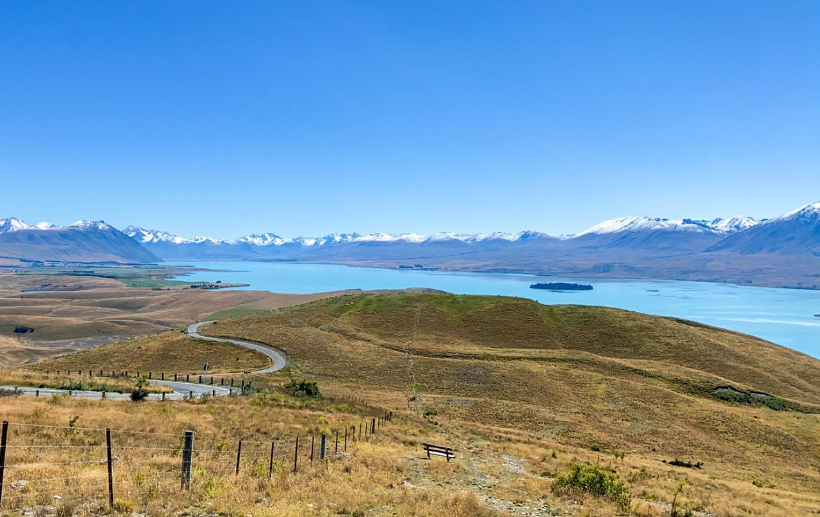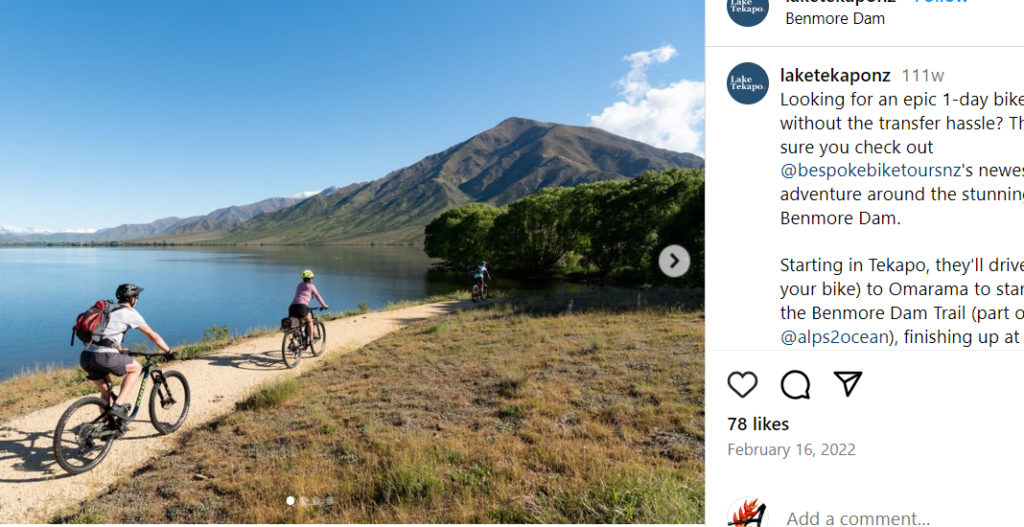
| Feature | Description |
|---|---|
| Location | Mackenzie District, Canterbury Region, South Island, New Zealand |
| Coordinates | 43°53′S 170°31′E |
| Surface Area | 83 km² (summer), 82 km² (winter) |
| Maximum Depth | 120 m |
| Average Depth | 69 m |
| Primary Inflows | Godley River, Macauley River, Mistake River, Cass River |
| Primary Outflow | Tekapo River |
| Catchment Area | 1,463 km² |
| Altitude | 710 m above sea level |
| Notable Features | Church of the Good Shepherd, Dark Sky Reserve, Lupins |
| Reference Link | Lake Tekapo – Wikipedia |
Lake Tekapo, also known by its Māori name Takapō, represents a natural spectacle nestled within the heart of New Zealand’s South Island. Framed by the rugged grandeur of the Southern Alps and adorned with the vivid hues of lupins, Lake Tekapo offers a canvas of breathtaking landscapes and serene beauty.
The Turquoise Jewel of the Mackenzie Basin
The lake’s signature milky-turquoise tint is a spectacle in its own right, originating from the fine glacial silt suspended in its waters. This unique characteristic is a testament to the lake’s glacial origins and serves as a magnet for photographers and nature enthusiasts alike. The lake spans approximately 83 km², set at an elevation of 710 meters, and its shores are a mosaic of vibrant lupins, especially from mid-November to the end of December, painting a vivid tableau against the backdrop of the Southern Alps.
Cultural Significance and History
The name Takapō is steeped in Māori culture, with legends recounting its creation by the ancestral explorer Rākaihautū. The area around Lake Tekapo was historically significant for the Ngāi Tahu tribe, known for its abundant eels and weka, which were essential for their sustenance. In more recent history, the dual names of Tekapo and Takapō have been officially recognized, honoring the lake’s rich heritage and cultural significance.
Astronomical Wonders Above
Designated as part of the Aoraki Mackenzie International Dark Sky Reserve, Lake Tekapo stands as a sentinel to the stars. The pristine clarity of the night skies here offers unparalleled opportunities for stargazing and astronomical observation. The observatory atop Mount John becomes a gateway to the cosmos, where one can marvel at the constellations unmarred by light pollution.
Adventures and Leisure
The Lake Tekapo area is not just about passive appreciation of nature’s wonders; it offers a plethora of activities ranging from leisurely walks along the lake’s edge to more adrenaline-pumping adventures. The Roundhill Ski Area provides winter sports enthusiasts with a variety of slopes catering to all levels, while the nearby hot springs offer a soothing retreat.
Hydroelectric Power and Environmental Conservation
Beyond its natural and recreational value, Lake Tekapo plays a critical role in New Zealand’s hydroelectric ecosystem. The Tekapo A and B power stations are pivotal in harnessing the kinetic energy of the lake’s outflows, contributing significantly to the region’s renewable energy resources.
Flora and Fauna
The ecosystem around Lake Tekapo is a vibrant testament to New Zealand’s diverse flora and fauna. The lake itself is home to sizeable populations of brown and rainbow trout, making it a favored spot for angling enthusiasts. The seasonal bloom of lupins, while visually stunning, also serves as a reminder of the delicate balance between introduced species and native ecosystems.
Preservation and Tourism
As Lake Tekapo continues to draw visitors from across the globe, the emphasis on preservation and sustainable tourism becomes ever more critical. Efforts to maintain the natural beauty and ecological integrity of the lake and its surroundings are paramount to ensuring that future generations can enjoy this jewel of New Zealand’s natural heritage.

Major Incidents at Lake Tekapo
Tragic Road Accidents
A devastating multi-vehicle crash occurred on State Highway 8 near Lake Pukaki, close to Lake Tekapo, resulting in the loss of four lives. The incident involved two vehicles and a motorcycle, with several of the injured having to be extricated from the wreckage. The crash, which took place around 1.30 pm on March 30, led to the closure of the highway for the remainder of the day. Police have been actively seeking witnesses to piece together the events leading up to this tragic occurrence. Among the victims were two Malaysian students, prompting condolences from Malaysian Prime Minister Anwar Ibrahim.
In a separate but equally harrowing incident on the same stretch of road, a crash involving two vehicles and a motorcycle claimed three lives and hospitalized five more. This crash, one of two within a span of less than two hours on the same road, involved over 20 people across the two separate incidents. The gravity of the situation was felt by emergency responders and the public, with one individual recounting the harrowing experience of performing CPR on the roadside.
Kayaking Tragedy
The serene waters of Lake Tekapo were the scene of a tragic kayaking accident that resulted in the deaths of an American and a British student. Strong winds overturned their kayaks, plunging them into the cold waters. Despite the group wearing life jackets, the sudden change in conditions led to this fatal outcome. Nine others were rescued from the incident, many suffering from hypothermia, underscoring the unpredictable nature of outdoor activities and the need for preparedness.
The Iconic Lakes of New Zealand
Lake Tekapo: A Turquoise Gem
Lake Tekapo, renowned for its vivid turquoise waters, is a standout among New Zealand’s lakes. Its stunning color, a result of finely ground rock particles from glaciers, makes it a photographer’s paradise. The Church of the Good Shepherd, perched on its shores, offers a picturesque view against the backdrop of the Southern Alps, making Lake Tekapo a must-visit destination.
Lake Wakatipu: The Longest Lake
Lake Wakatipu, with its serpentine shape, holds the title of the longest lake in New Zealand. Surrounded by majestic mountains, including the Remarkables Range, it offers breathtaking views and a plethora of recreational activities. The vibrant town of Queenstown on its shores adds to the lake’s allure, making it a hub for adventure enthusiasts.
Lake Pukaki: The Glacier’s Gift
Lake Pukaki’s ethereal beauty is accentuated by its milky turquoise waters, a result of glacial flour from the surrounding Southern Alps. The lake provides a perfect frame for Mount Cook, New Zealand’s highest peak, offering stunning vistas that captivate visitors. The surrounding Mackenzie Basin enhances its picturesque setting, making Lake Pukaki a jewel in New Zealand’s crown.
Lake Wanaka: Serenity and Adventure
Lake Wanaka stands out for its tranquil beauty and the adventure opportunities it offers. Surrounded by mountains and the gateway to Mount Aspiring National Park, it’s a haven for outdoor enthusiasts. The famous lone tree standing in its waters has become an iconic image, symbolizing the lake’s serene and untouched nature.
Lake Taupo: The Caldera Lake
Lake Taupo, the largest lake in New Zealand by surface area, is actually a caldera formed by a volcanic eruption. This lake is a hotspot for fishing, especially for trout, and offers a variety of water sports. The nearby Huka Falls and the Mine Bay Maori carvings are popular attractions that add to the lake’s appeal.
Lake Manapouri: The Deep Wonder
Situated near Fiordland National Park, Lake Manapouri is among the deepest lakes in New Zealand. Its untouched wilderness and the backdrop of Cathedral Mountains make it a place of profound beauty and tranquility. The lake is also the gateway to Doubtful Sound, adding to its allure as a pristine natural wonder.
Lake Hawea: The Adventurer’s Playground
Just a stone’s throw away from Lake Wanaka, Lake Hawea is a haven for those seeking adventure in the great outdoors. Its deep blue waters, surrounded by steep mountains, create a dramatic landscape perfect for kayaking, fishing, and hiking. The lake’s vast expanse and rugged beauty make it a favorite among adventure seekers.
Lake Te Anau: Gateway to Fiordland
Lake Te Anau, nestled on the edge of Fiordland National Park, is the second-largest lake in New Zealand. It serves as a gateway to some of the country’s most famous fiords, including Milford Sound. The lake’s western shores are lined with lush forests, offering spectacular walking tracks and the opportunity to explore the renowned Te Anau Glowworm Caves.
Lake Matheson: The Reflective Beauty
Famous for its mirror-like reflections of Mount Cook and Mount Tasman, Lake Matheson encapsulates the essence of New Zealand’s scenic beauty. The surrounding ancient forests and the clear waters create a tranquil atmosphere, making it a perfect spot for photography and nature walks.
Lake Ohau: The Alpine Retreat
Part of the glacial trio in the Mackenzie Basin, Lake Ohau offers serene beauty and an alpine retreat. The lake is a popular spot for skiing at the Ohau Snow Fields, offering breathtaking views of the Southern Alps. In the warmer months, it becomes a haven for hikers and cyclists exploring its scenic trails.
Lake Rotoiti: The Nelson Lakes Jewel
Located in the Nelson Lakes National Park, Lake Rotoiti is a haven for nature lovers. Surrounded by the majestic Saint Arnaud Range, the lake offers stunning alpine scenery and a plethora of outdoor activities, from kayaking to hiking. The lake’s clear waters and native forests provide a peaceful escape into nature.
Emerald Lakes: The Volcanic Marvels
Situated in Tongariro National Park, the Emerald Lakes are famed for their striking colors and volcanic landscape. Part of the Tongariro Alpine Crossing, these lakes dazzle with hues ranging from turquoise to emerald green, set against the dramatic backdrop of volcanic terrain.




